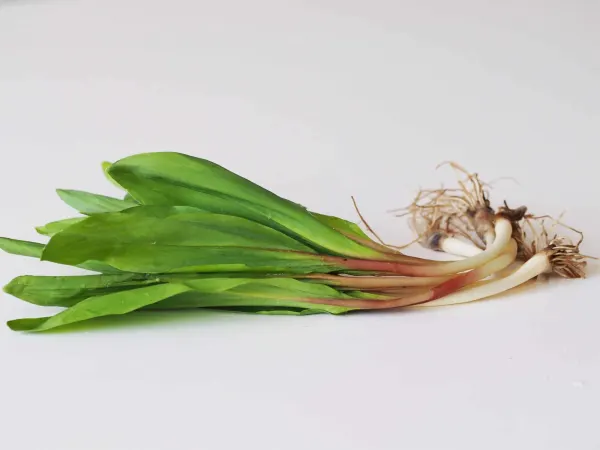Ramps
Vegetable
Age Suggestion
6 months
Iron-Rich
No
Common Allergen
No

When can babies eat ramps?
Ramps may be introduced as soon as baby is ready to start solids, which is generally around 6 months of age.
Where do ramps come from?
Ramps are a rare treat that are mainly foraged in the upland woods of Canada, Appalachia, and the northern regions of the United States. To ensure that ramps continue to thrive, responsible harvesters cut only the leaves, letting the bulb stay intact in the ground to grow again another year. Ramps are an allium—a plant family that includes onions, leeks, shallots, and garlic. In fact, to some, they are “wild leeks” or “wild garlic” instead of “ramps,” which is the Appalachian name for the plant. Ramps are an important part of Cherokee cooking, valued both for their medicinal properties and flavor.
Videos
Are ramps healthy for babies?
Yes. Ramps likely have a nutritional profile similar to other allium plants (leeks, chives, and scallions), though the data on their specific nutrient content is lacking. Wild ramps contain vitamin A and folate, nutrients that support your baby’s vision and healthy development. Ramps also take up minerals from the soil in which they grow, including iron. Ramps also contain fiber, which is great for digestion, and powerful phytonutrients that have antibacterial, antioxidant, and antiviral properties to help keep you and baby healthy.
Are ramps a common choking hazard for babies?
No. Ramps, when chopped and incorporated into other foods, are not a common choking hazard, though in theory, an individual can choke on any food. As always, make sure you create a safe eating environment, stay within an arm’s reach of baby during meals, and check out our age-appropriate serving suggestions.
For more information on choking, visit our sections on gagging and choking and familiarize yourself with the list of common choking hazards.
Are ramps a common allergen?
No. Allergies to ramps are rare, though there is some evidence that allergies to plants in the onion family are increasing. Of note, some allergens in foods in this family are sensitive to heat, meaning that well-cooked ramps might be well-tolerated in an individual who is sensitive to raw ramps. Individuals with Oral Allergy Syndrome (also called pollen fruit syndrome), and in particular, those with sensitivities to grass pollen or mugwort pollen (a weed) may also be sensitive to ramps. Oral Allergy Syndrome typically results in short-lived itching or burning in the mouth and is unlikely to result in a dangerous reaction.
As you would when introducing any new food, start by serving a small quantity for the first couple of times. If there is no adverse reaction, gradually increase the quantity over future servings.
How do you prepare ramps for babies with baby-led weaning?
Every baby develops on their own timeline, and the suggestions on how to cut or prepare particular foods are generalizations for a broad audience.
6 to 12 months old:
Mix a small amount of sautéed ramps into scrambled eggs or quiches, and try using them in place of onions in meatballs and patties. You can also sauté ramps in butter or olive oil and spread the oniony sauce on bread, chicken, or fish or mix it into pasta or a grain dish for little ones to scoop with their hands.
12 to 18 months old:
This is a great age to introduce ramp butter! Blend raw ramps with butter and start small; ramps can be a bit tough on the belly, just like garlic. Ramp butter is a delicious topping for bread, green beans, fish, and chicken dishes.
18 to 24 months old:
At this age your baby may be getting quite selective with food choices, but there is one food that most babies love: mascarpone cheese. Stir minced ramps into mascarpone cheese and spread on toast, fold into sauces, and mix into quiches.
Like leeks and other onions, ramps benefit from a slow, steady sauté. Cook on medium low heat in some butter or olive oil until completely soft and translucent.
For more information on how to cut food for babies, visit our page on Food Sizes & Shapes.
Written and reviewed by these specialists
E. Cerda, MSN, CNS, LDN
A. Gilbaugh, RD, CNSC
K. Grenawitzke, OTD, OTR/L, SCFES, IBCLC, CNT
S. Bajowala, MD, FAAAAI. Board-Certified Allergist & Immunologist (allergy section)
R. Ruiz, MD, FAAP. Board-Certified General Pediatrician & Pediatric Gastroenterologist
Expert Tips Delivered to Your Inbox
Sign up for weekly tips, recipes and more!
The content offered on SolidStarts.com is for informational purposes only. Solidstarts is not engaged in rendering professional advice, whether medical or otherwise, to individual users or their children or families. No content on this site, regardless of date, should ever be used as a substitute for direct medical advice from your doctor or your medical or health professional, nutritionist, or expert in pediatric feeding and eating. By accessing the content on SolidStarts.com, you acknowledge and agree that you are accepting the responsibility for your child’s health and well-being. In return for providing you with an array of content “baby-led weaning” information, you waive any claims that you or your child may have as a result of utilizing the content on SolidStarts.com.



